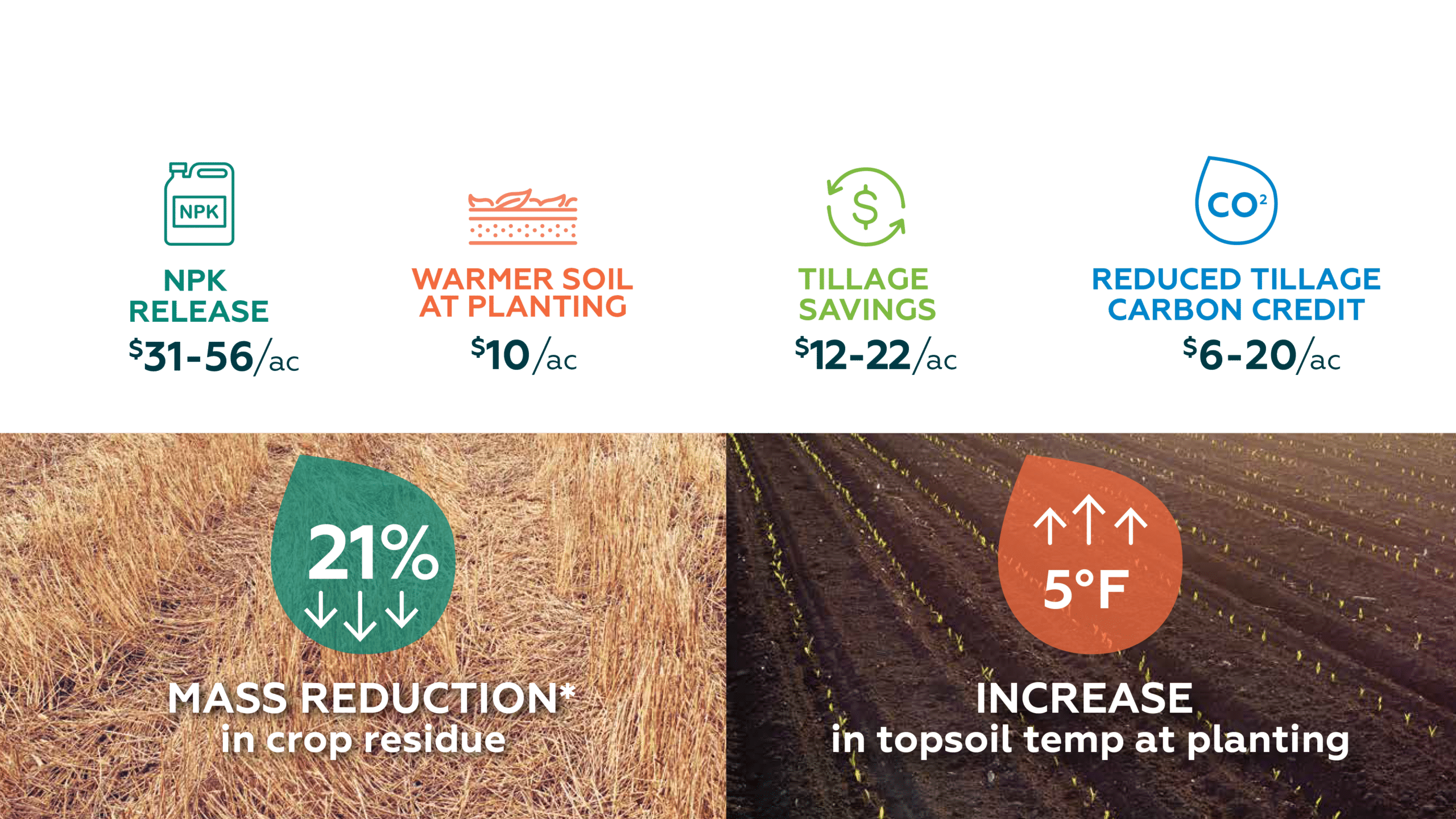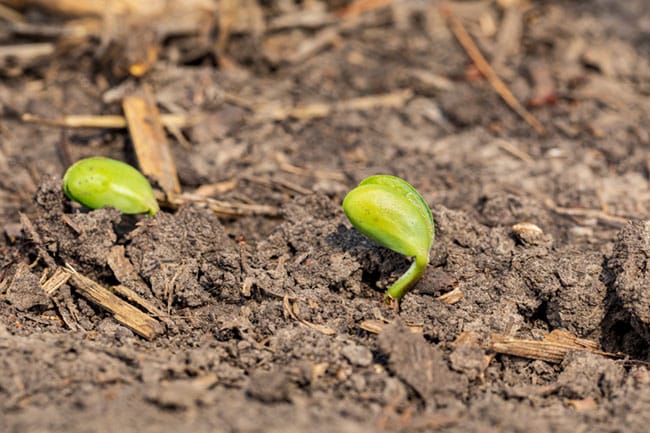Apr 11, 2025



Have you ever heard the saying, “You’ll get out what you put into it?”
People often use this when referring to a class, conference, or opportunity. But, did you know that when it comes to the success of next year’s crops, you’ll also get out what you put into fall and spring?
By “what you put into it”, we don’t just mean water and fertilizer. We mean water, fertilizer, a comprehensive seed treatment to support germination and stand, as well as leveraging your post-harvest residue as a slow nutrient source. In other words, what you put into decomposing your crop residue and supporting seeds is what you’ll get out of next year’s crops.
Growers would be smart to pair a carbon-rich microbial food (like PhycoTerra) to reduce crop residue in the fall with a strategic seed treatment program (including PhycoTerra ST) in the spring to maximize yield potential.
Historically, burning and tilling have been a common practice for post-harvest residue management. Recent studies suggest tilling and burning can be “counterproductive from an economic and environmental perspective.”
Despite the common myth about tilling, it has no direct effect on residue breakdown. Another myth – applying nitrogen fertilizer post-harvest – also does not effectively improve the rate of decomposition for residue. Myths aside, tilling and burning have been found to damage the soil microbiome, which is integral to plant health. Plus, there are additional drawbacks to tilling or burning.
With all these negatives, it’s time to find new solutions to manage post-harvest residue. Studies show decreasing tilling and increasing residue (like cover crops and cash crops) are good for improving soil health. Yet, leaving the residue in the field to break down on its own isn’t a great option either.
Excess crop residue in the spring can create poor seedbed conditions, spread soil diseases, and create nitrogen immobilization. Additionally, it can be difficult to plant around and can pop equipment tires.
The temperature, pH, oxygen level, soil microbial community, and moisture influence the rate of decomposition. What growers need is a way to speed up the decomposition of their crops while leaving post-harvest residue in the field.
By doing so, crop residue can improve soil health, feed soil microbes, and act as a slow-release nutrient source for next year’s crops.
Post-harvest residue can feed soil microbes and, in turn, work for growers. While in the past crop residue has been known to clog equipment, delay spring warm-up, increase pathogens, and increase NPK immobility, this doesn’t have to be the case if you break down your crop residue faster.
Decomposition is largely determined by a biological process influenced by environmental and soil conditions. PhycoTerra can help leverage soil microbes to improve decomposition speeds when applied to the residue post-harvest.
Growers can’t just hope this process happens without their help. Roughly 75% of soil microbes are starving and dormant, which means they aren’t improving your soil quality, next year’s yield potential, or breaking down excess crop residue.
A new way to reduce post-harvest residue in your field is to feed soil microbes to increase the decomposition speed of crop residue. This option is more cost-effective compared to tilling and burning. It also pairs well with burndown herbicide and has an easy application without storage requirements or special equipment.
PhycoTerra provides an active carbon food source to wake up your microbes to support crop residue breakdown with an application rate of 1-2 quarts/acre. Feeding soil microbes also promotes warmer soil temperature and increases nutrient levels in your soil.

Feeding your soil microbes for post-harvest residue management can also benefit your winter wheat! By adding PhycoTerra, growers in Washington found a 4:1 ROI and +2.3 bu/acre.
Beyond post-harvest residue management, active soil microbes also provide a long list of benefits to your soil and crops throughout the year, such as:
While you’re managing post-harvest residue (one trial found a 36% reduction) you’ll also be supporting next year’s harvest.
It’s in a grower’s best interest to keep their soil covered, maximize periods of living root growth, provide plant diversity, and minimize soil disturbance. Let PhycoTerra take care of fall crop residue and decompose what’s left in your field to the benefit of your planting season in the spring.
Leveraging soil microbes to break down crop residue is a sustainable agriculture practice with impactful ROIs.
| Savings Type | Amount |
| NPK Savings | $31 – $56/acre |
| Warmer Soil Planting | $10/acre |
| Tillage Savings | $12 – $22/acre |
| Reduced Carbon Savings | $6 – $22/acre |
Plus, growers will get their seeds in the ground earlier, with a 5 Fahrenheit increase in topsoil at planting. This can be the difference between a day to an extra week when it comes to planting time.
During planting season, seeds face a significant number of threats, including pests, drought, fungal and bacterial seed-borne pathogens, limited resources, and poor habitat suitability. To stack the odds in favor of the seeds, growers use seed treatment plans.

Seed treatments enhance germination and early plant development. Adding PhycoTerra ST to your current seed treatment plan can supercharge the spermosphere function.
For a seed, soil microbes are their first interaction with the “real world”. They interact with seeds at the spermosphere, a short-lived microbial distinct zone around the seed.
PhycoTerra ST leverages soil microbes at the seed, and surrounding the seed, to influence seed development. Our proprietary formula of microalgae super food wakes up dormant soil microbes. Once active, microbes can improve NPK availability, provide abiotic stress relief, release antioxidants, and optimize conditions.
By adding PhycoTerra ST, you’ll be helping your seeds make the most of your nutrient application, increase nutrient uptake, withstand drought, and lead to higher crop yields and increased ROIs. Our low application rate delivers a notable, consistent ROI and yield increases.
| Crop | ROI | BU or LBS/AC | Win Rate |
| Corn | 67:1 | +10.2 | 67% |
| Soybeans | 21:1 | +2.4 | 69% |
| Wheat | 13:1 | +4.9 | 82% |
| Cotton | 177:1 | +51.6 | 100% |
| Canola | 308:1 | +3.03 | 75% |
| Sorghum | 167:1 | +3.5 | 100% |
Much like supporting any of your crops, supporting soil microbes is a year-round job. At the end of a harvest season, soil microbes can pay off much like your crop yield can. Feed soil microbes to manage post-harvest residue, feed them again around the spermosphere when planting, and feed them a third time during the growing season.
Before the winter hits, conduct a soil test with a trusted adviser. They can help you make a plan to support the physical, biological, and chemical soil properties. Consider adding compost and mulch to support your current or added soil biology. A cover crop can also support soil health and soil quality.
Note: All trial data is current as of blog posting. For the most up to date trail data, please visit our trials page.